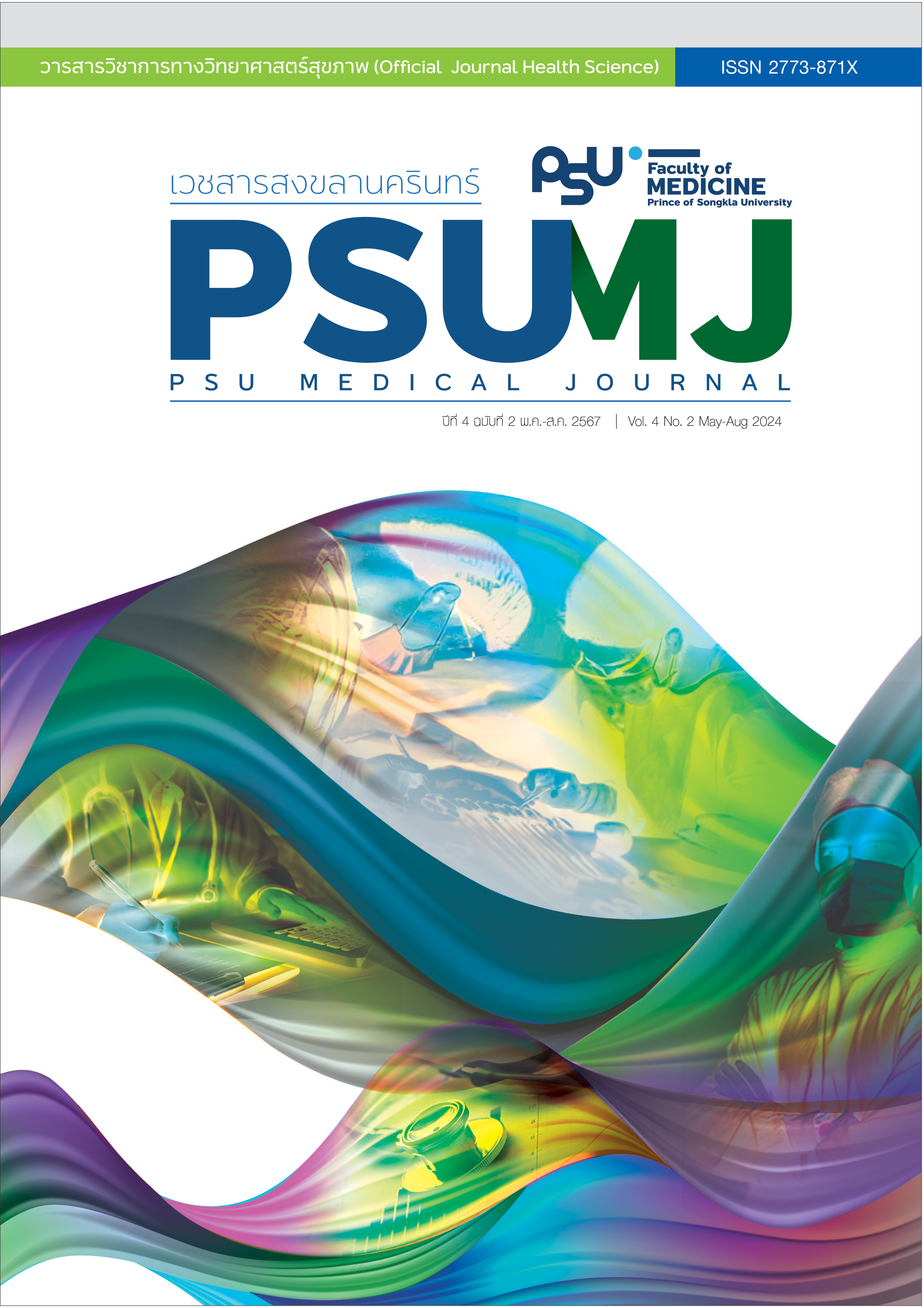Variations in the Association between Economic Distress and Anxiety by Availability of Emergency Cash Reserves: Findings from a Longitudinal Study
DOI:
https://doi.org/10.31584/psumj.2024266120Keywords:
anxiety, economic distress, emergency savings, longitudinal studyAbstract
Objective: 1) to describe the extent that experience of economic distress is associated with incidence of anxiety, and; 2) modification of the mentioned association by availability of emergency cash reserves.
Material and Methods: We conducted a longitudinal study using two phone-based surveys in the general population of Thailand in April and May, 2021. We analyzed data using descriptive statistics and log-binomial regression analyses.
Results: There were 1135 persons who met the inclusion criteria and participated in both surveys (non-participation at baseline=31.7%; loss-to-follow-up=420/1555=14.4%). The association between economic distress and anxiety was stronger among participants with no emergency cash reserves (Adjusted RR=2.05, 95% CI=0.86, 4.90) and more moderate among participants with emergency cash reserves (Adjusted RR=1.70, 95% CI=0.31, 9.43).
Conclusion: The study results appeared to support our hypothesis despite lack of statistical significance. However, the lack of adjustment for other predictors of anxiety, and the lack of ability to generalize to other phases of the COVID-19 pandemic should be considered as caveats in the interpretation of our study findings.
References
Newman MG, Llera SJ, Erickson TM, Przeworski A, Castonguay LG. Worry and generalized anxiety disorder: a review and theoretical synthesis of evidence on nature, etiology, mechanisms, and treatment. Annu Rev Clin Psychol 2013;9:275–97.
Zumbrun J. Coronavirus slump is worst since great depression. Will it be as painful? Wall Street J [serial on the Internet]. 2019 [cited 2022 Feb 9]. Available from: https://www.wsj.com/articles/coronavirus-slump-is-worst-since-great-depression-will-itbe-as-painful-11589115601
Santabárbara J, Lasheras I, Lipnicki DM, Bueno-Notivol J, Pérez-Moreno M, López-Antón R, et al. Prevalence of anxiety in the COVID-19 pandemic: an updated meta-analysis of community-based studies. Prog Neuropsychopharmacol Biol Psychiatry 2021;109:110207.
Hertz-Palmor N, Moore TM, Gothelf D, DiDomenico GE, Dekel I, Greenberg DM, et al. Association among income loss, financial strain and depressive symptoms during COVID-19: Evidence from two longitudinal studies. J Affect Disord 2021;291:1–8.
Boss P. Family Stress Management: a contextual approach 2nd ed. Californail: Sage Publications, Inc; 2012. Chen A. Why are so many households unable to cover a $400 unexpected expense? [monograph on the Internet]. Newton: Center for Retirement Research at Boston College; 2019 [cited 2022 Feb 9]. Available from: https://crr.bc.edu/wp-content/uploads/2019/07/IB_19-11.pdf.
Bell MM, Nelson JS, Spann SM, Molloy CJ, Britt SL, Goff BSN. The impact of financial resources on soldiers’ well-being. J Financ Couns Plan 2014;25:41–52.
Bridges S, Disney R. Debt and depression. J Health Econ 2010;29:388–403.
Ford MR, Ellis ÉM, Goetz J, Archuleta KL, Gale JE, Grossman B, et al. Depression and financial distress in a clinical population: The value of interdisciplinary services and training. Contemp Fam Ther 2020;42:5-14
Siahpush M, Carlin JB. Financial stress, smoking cessation and relapse: results from a prospective study of an Australian national sample. Addiction 2006;101:121–7.
Sweet E, Nandi A, Adam EK, McDade TW. The high price of debt: household financial debt and its impact on mental and physical health. Soc Sci Med 2013;91:94–100.
Wichaidit W, Prommanee C, Choocham S, Chotipanvithayakul R, Assanangkornchai S. Modification of the association between experience of economic distress during the COVID-19 pandemic and behavioral health outcomes by availability of emergency cash reserves: findings from a nationally-representative survey in Thailand. PeerJ 2022;10:e13307.
Richardson T, Elliott P, Waller G, Bell L. Longitudinal relationships between financial difficulties and eating attitudes in undergraduate students. Int J Eat Disord 2015;48:517–21.
Frankham C, Richardson T, Maguire N. Do locus of control, self-esteem, hope and shame mediate the relationship between financial hardship and mental health? Community Ment Health J 2020;56:404–15.
Richardson T, Elliott P, Roberts R, Jansen M. A longitudinal study of financial difficulties and mental health in a national sample of british undergraduate students. Community Ment Health J 2017;53:344–52.
Chongsuvivatwong V. Analysis of epidemiological data using r and epicalc. Songkhla: Epidemiology Unit, Prince of Songkla University; 2015;p.314
Faculty of Medicine Ramathibodi Hospital. General Anxiety Disorder (GAD-7) Questionnaire [homepage on the Internet]. Bangkok: Faculty of Medicine Ramathibodi Hospital Mahidol University; 2018 [cited 2021 May 21]. Available from: https://med.mahidol.ac.th/ramamental/questionnair
Kroenke K, Spitzer RL, Williams JBW, Monahan PO, Löwe B. Anxiety disorders in primary care: prevalence, impairment, comorbidity, and detection. Ann Intern Med 2007;146:317–25.
Board of Governors of the Federal Reserve System. Report on the Economic Well-Being of U.S. Households in 2018 [homepage on the Internet]. Washington, DC: Federal Reserves; 2019 [cited 2021 May 21]. Available from: https://www.federalreserve.gov/publications/files/2018-report-economicwell-being-us-households-201905.pdf
World Bank. GDP per capita (current US$) [homepage on the Internet]. Washington, DC: World Bank; 2021 [cited 2021 May 21]. Available from: https://data.worldbank.org/indicator/ny.gdp.pcap.cd?most_recent_value_desc=true
World Bank. GDP per capita, PPP (current international $) [homepage on the Internet]. Washington, DC: World Bank; 2021 [cited 2021 May 21]. Available from: https://data.worldbank.org/indicator/NY.GDP.PCAP.PP.CD?most_recent_value_desc=true
Thailand National Statistical Office. Demographics, Population, and Household Statistics [homepage on the Internet]. Bangkok: National Statistical Office; 2020 [cited 2021 Oct 7]. Available from: http://statbbi.nso.go.th/staticreport/page/sector/th/01.aspx
Fallon B, Lefebvre R, Collin-Vézina D, Houston E, Joh-Carnella N, Malti T, et al. Screening for economic hardship for child welfare-involved families during the COVID-19 pandemic: a rapid partnership response. Child Abuse Negl 2020;104706.
Dour HJ, Wiley JF, Roy-Byrne P, Stein MB, Sullivan G, Sherbourne CD, et al. Perceived social support mediates anxiety and depressive symptom changes following primary care intervention. Depress Anxiety 2014;31:436–42.
Bank of Thailand. Bank of Thailand and Assistance Measures during the COVID-19 Pandemic Situation [homepage on the Internet]. Bangkok: Bank of Thailand; 2020 [cited 2022 Mar 27]. Available from: https://www.bot.or.th/covid19/Pages/default.aspx
Prawitz AD, Kalkowski JC, Cohart J. Responses to economic pressure by low-income families: Financial distress and hopefulness. J Fam Econ 2013;34:29–40.
Downloads
Published
How to Cite
Issue
Section
License
Copyright (c) 2024 Author and Journal

This work is licensed under a Creative Commons Attribution-NonCommercial-NoDerivatives 4.0 International License.








